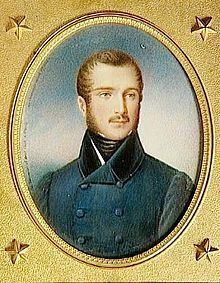Predecessor Louis I Name Napoleon Bonaparte Burial Saint-Leu-la-Foret | Regent Napoleon Predecessor Joachim I Role King | |
 | ||
Reign 1 July 1810 – 13 July 1810 Reign 3 March 1809 – 1 December 1813 Died March 17, 1831, Forli, Italy Spouse Charlotte Bonaparte (m. 1826) Books The Political and Historical Works of Louis Napoleon Bonaparte: Volume II Parents Louis Bonaparte, Hortense de Beauharnais Siblings Napoleon III, Napoleon Charles Bonaparte Similar People Louis Bonaparte, Napoleon III, Hortense de Beauharnais, Charlotte Bonaparte, Alexandre de Beauharnais | ||
Napol on louis bonaparte
Napoléon-Louis Bonaparte (11 October 1804 – 17 March 1831), also known as Louis II of Holland, was the middle son of Louis I of Holland and Hortense de Beauharnais. His father was the younger brother of Napoléon I and reigned as King of Holland from 1806 to 1810, while his mother was the daughter of Josephine de Beauharnais, Napoléon's first wife. He was the older brother of Louis Napoleon Bonaparte, future Emperor Napoleon III.
Contents
Background

Napoléon Louis's elder brother, Napoléon Charles, died in 1807 at the age of four. On his death, Napoléon Louis became Prince Royal of Holland. It also made Napoléon Louis the second eldest nephew of Emperor Napoléon I, who at the time had no legitimate children, and he was his uncle's likely eventual successor. He lost this presumptive status on 20 March 1811 when his uncle's second wife, Marie Louise, gave birth to a son, Napoléon François Joseph Charles Bonaparte, who was styled the King of Rome and later the Duke of Reichstadt.

In 1809, Napoléon I appointed him as Grand Duke of Berg, a status he kept until 1813.
On 1 July 1810, Louis I of Holland abdicated his throne in favour of Napoléon Louis. For the nine days between his father's abdication and the fall of Holland to the invading French army in July 1810, Napoléon Louis reigned as Lodewijk II, King of Holland.
When Napoléon I was deposed in 1815 after the Battle of Waterloo, the House of Bourbon was restored to the throne of France. Napoléon Louis fled into exile, but the Bonapartes never abandoned the thought of restoring the Napoleonic Empire.
Napoléon Louis married his first cousin, Charlotte, who was the daughter of Joseph Bonaparte, eldest brother of Napoléon I. He and his younger brother Louis-Napoléon Bonaparte settled in Italy, where they espoused liberal politics and became involved with the Carbonari, an organization fighting Austria's domination of northern Italy.
On 17 March 1831, while fleeing Italy due to a crackdown on revolutionary activity by Papal and Austrian troops, Napoléon Louis, suffering from measles, died in Forlì. Eventually, the Napoleonic Empire was restored by Napoléon Louis's younger brother, who became Napoléon III in 1852.
Napoléon Louis is buried at Saint-Leu-La-Foret, Île-de-France.
Titles and Styles
Full title as King of Holland
His Majesty Louis II, By the Grace of God and the Constitution of the Kingdom, King of Holland.
